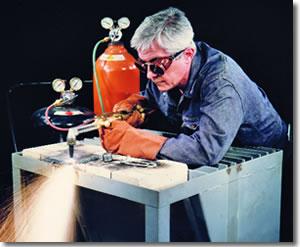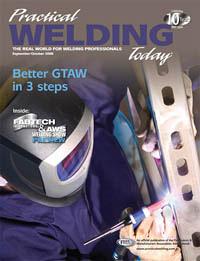Contributing Writer
- FMA
- The Fabricator
- FABTECH
- Canadian Metalworking
Categories
- Additive Manufacturing
- Aluminum Welding
- Arc Welding
- Assembly and Joining
- Automation and Robotics
- Bending and Forming
- Consumables
- Cutting and Weld Prep
- Electric Vehicles
- En Español
- Finishing
- Hydroforming
- Laser Cutting
- Laser Welding
- Machining
- Manufacturing Software
- Materials Handling
- Metals/Materials
- Oxyfuel Cutting
- Plasma Cutting
- Power Tools
- Punching and Other Holemaking
- Roll Forming
- Safety
- Sawing
- Shearing
- Shop Management
- Testing and Measuring
- Tube and Pipe Fabrication
- Tube and Pipe Production
- Waterjet Cutting
Industry Directory
Webcasts
Podcasts
FAB 40
Advertise
Subscribe
Account Login
Search
Fuel your safety knowledge
Use old, new rules with oxyfuel
- By John Uccellini
- October 3, 2006
- Article
- Safety
 |
The following is an oxyfuel safe practices overview that includes newer changes to the "dos and don'ts." The preliminary "do," of course, is training, which you should have before you pick up a torch.
Experiencing Withdrawal?
One of the most common errors in oxyfuel system use is acetylene overwithdrawal from cylinders. For many years the rule of thumb has been that maximum withdrawal from a single cylinder is 1/7 of its contents at a pressure not to exceed 15 pounds per square inch gauge (PSIG) with 103 kilopascals (kPa). While these numbers have been used for many years, the Compressed Gas Association (CGA) has changed the withdrawal rate (see CGA G1 5.3.3.13):
To minimize the withdrawal of liquid solvent, acetylene should be withdrawn from the cylinder at a rate not to exceed one-tenth (1/10) of the capacity of the cylinder per hour during intermittent use. For full withdrawal of the contents of the cylinder on a continuous basis, the flow rate should be no more than one-fifteenth (1/15) of the capacity of the cylinder per hour.
If you don't adhere to withdrawal rates, acetone (contained in the acetylene cylinder to stabilize the acetylene gas) will be drawn off with the gaseous acetylene. This acetone reduction from the cylinder makes the cylinder unstable and poses an explosive hazard. The acetone withdrawn with the acetylene gas passes through the regulator and on through the entire system. If this happens, cutting or welding quality decreases and the acetone deteriorates any rubber or plastic parts of the system. Typically, the regulator will fail and shut down the system before the cylinder becomes unstable.
A favorite story is about a distributor representative who called in because one of his customers could not get enough acetylene to do the job. The technical representative he talked to recommended a new, larger acetylene regulator. The next day the distributor representative reported that the new regulator wasn't working. When asked how many cylinders were being used in the heavy heating job they were attempting, the representative answered, "One 300-cubic-foot cylinder." Failure of the regulator probably saved the cylinder from reaching the explosive point.
In some situations so much acetone has been withdrawn that the hoses bulge and burst. That's why you must pay close attention to withdrawal rates—equipment failure won't always save you from an explosive situation.
An acetylene cylinder with 360 cu. ft. can supply 36 cubic feet per hour (CFH) with intermittent use and only 24 CFH in continuous use. This makes manifolding of acetylene cylinders a must in heavy-duty applications.
Any regulator you use with acetylene must have a 15-PSIG red-line gauge. Regulators that have the acetylene and other fuel gas No. 510 CGA inlet connection but don't have the 15-PSIG red-line gauge must be marked "not for use with acetylene."
Another common misconception about acetylene is that cylinders must be in the upright position. While this is the recommended practice, acetylene is no less stable while lying on its side. However, safety is enhanced when cylinders are upright because in this position, access to regulators and cylinders is less complicated. Never open an acetylene cylinder valve more than 11/2 turns. Also, leave the key on the valve if one is needed to open the valve. This allows for quick shutoff in an emergency.
Emergency Shutoff
As with cylinders, emergency torch shutoff is an important safety topic. Oxyfuel torches can be shut down in one of two ways. One is to turn off the fuel gas first and the oxygen second; the other method is the reverse. Both techniques have been used for years, and both are correct when the torch manufacturer's instructions are followed correctly.
Generally, the preferred sequence today is to shut the oxygen off first and then shut off the fuel quickly. This eliminates a minor backfire that sounds like a pop. Shutting off the oxygen first prevents the flame from becoming oxygen-rich, which reduces the flame's stability. Shutting off the fuel second allows for detection of leaks in the fuel valve.
New Hose Grade
Another fairly new development in oxyfuel is the new grade T hose for use with fuel gas (including acetylene). This grade replaces the former grade M. The material is similar, but the testing of the grade T is more stringent.
Grades R and RM are for use with acetylene only.
Don't Forget the Rules—Old and New
Although you should follow current guidelines for oxyfuel safety, also make sure to abide by longstanding safety rules. Accidents can occur when equipment is used or maintained improperly. Most safe practices are based on experience and common sense, while others would need volumes to explain. A short list of important procedures includes the following:
Before attaching the regulator to the cylinder valve, turn the valve away from you and crack the valve to blow out any foreign material. Be sure to check oxygen valves for grease or oil. Oxygen is flammable or even explosive in the presence of grease or oil. While cracking the cylinder valve with oxygen and inert gases is common practice, the cracking of cylinder valves for fuel gases is not recommended, as it releases flammable gas to the area.
Check for leaks with a compatible leak detection solution after attaching the regulator, hose, and torch. Don't use leaking equipment. Have leaks repaired or replaced before use.
Purge lines before lighting the torch. Open each valve in turn long enough for the pure gas to purge out any gas mixtures. Shut one valve before opening the next. Don't purge in a confined space, in the presence of a flame or other source of ignition, or toward people.
Check valves prevent the reverse flow of gases into the hose, but aren't a substitute for purging the lines. Test check valves regularly to make sure they function reliably: Apply reverse flow of gas to the check valve and test for leaks. Check valves are not designed to stop a flame. For maximum safety, use flashback arresters. Most flashback arresters incorporate check valves. While these arresters will help prevent and protect against flashbacks and backfires, no device can replace safe operating practices and properly maintained equipment.
Never operate oxyfuel equipment in a confined space. Be sure the work area has adequate ventilation. Do not use oxygen to ventilate the work area (see American National Standards Institute standard Z.49.1 for more information).
Wear protective clothing, gauntlet gloves, a hat, and safety-toed shoes. Keep your shirt collar and pocket flaps buttoned, and wear cuffless trousers to prevent sparks and slag from getting trapped in them.
Don't work in an oxygen-enriched area (more than 23 percent O2) or in oxygen-depleted (less than 19 percent O2) atmospheres.
It's dangerous to clean clothing with an oxygen stream or hang clothing on oxygen cylinders. Clothing that has been saturated with oxygen will burn intensely if ignited by spark or flame.
Gloves and rags contaminated with grease, oil, and oil-bearing materials can ignite in the presence of oxygen. Keep oil and grease away from oxygen equipment.
Stand behind the oxygen cylinder, and be sure the regulator-adjusting screw, or T handle, is turned out or counterclockwise. Open the oxygen cylinder valve slowly and open it all the way (unlike the fuel cylinder, which must be opened only a maximum of 11/2 turns).
The oxygen cylinder valve is designed to be leak-free if the valve stem is opened all the way. If you open the oxygen valve too quickly, you can cause an oxygen regulator fire. The oxygen compressed in the cylinder will recompress when it's forced into the regulator. This recompression causes high heat that can ignite any foreign material in the oxygen regulator and create a regulator fire. Recompression heat can be so hot that the body of the regulator can become the fuel for the fire. For this reason, use of aluminum oxygen regulators is discouraged. The Food and Drug Administration (FDA) has issued an advisory warning of the dangers associated with aluminum oxygen regulators.
Be sure to use the correct tip for the job intended, and set the tip to the specifications provided by the manufacturer. Use the proper tip for the fuel gas being employed.
Prevent flashback by knowing its causes:
- The tip is too close or is touching the work.
- Foreign particles in the tip, which can impede gas flow.
- Tip overheating, which can be caused by working in corners.
- Operating with incorrect gas flow.
Always use a sparklighter to light a tip. Never use matches or cigarette lighters. Avoid lighting over hot work. Don't use the torch as a slag hammer or pry bar; equipment abuse can cause accidents. Purge your lines each time you relight your torch.
If you leave oxyfuel equipment unattended for a short time or overnight, extinguish the flame by closing the torch and the cylinder valves. When leaving equipment over the weekend or longer, close both valves, and drain gas from the system by opening the torch valves and the regulators in a safe direction. Close the valves one at a time. If the equipment is in a public area, disconnect and store the equipment to prevent unauthorized use. Do not store gas cylinders—especially with connected equipment—in unvented cabinets, vehicles, or other confined spaces.
Transporting gas cylinders by cars and vans is dangerous. Transporting propane cylinders by car or van isn't recommended because they are likely to be handled by inexperienced users and sometimes by children.
John Uccellini is manager of technical services for CONCOA, 1501 Harpers Road, Virginia Beach, VA 23454, 800-225-0473, e-mail@concoa.com, www.concoa.com.
About the Author
About the Publication
subscribe now

The Welder, formerly known as Practical Welding Today, is a showcase of the real people who make the products we use and work with every day. This magazine has served the welding community in North America well for more than 20 years.
start your free subscription- Stay connected from anywhere

Easily access valuable industry resources now with full access to the digital edition of The Fabricator.

Easily access valuable industry resources now with full access to the digital edition of The Welder.

Easily access valuable industry resources now with full access to the digital edition of The Tube and Pipe Journal.
- Podcasting
- Podcast:
- The Fabricator Podcast
- Published:
- 04/16/2024
- Running Time:
- 63:29
In this episode of The Fabricator Podcast, Caleb Chamberlain, co-founder and CEO of OSH Cut, discusses his company’s...
- Trending Articles
Sheffield Forgemasters makes global leap in welding technology

ESAB unveils Texas facility renovation

Engine-driven welding machines include integrated air compressors

The impact of sine and square waves in aluminum AC welding, Part I

Compact weld camera monitors TIG, plasma processes

- Industry Events
16th Annual Safety Conference
- April 30 - May 1, 2024
- Elgin,
Pipe and Tube Conference
- May 21 - 22, 2024
- Omaha, NE
World-Class Roll Forming Workshop
- June 5 - 6, 2024
- Louisville, KY
Advanced Laser Application Workshop
- June 25 - 27, 2024
- Novi, MI


























